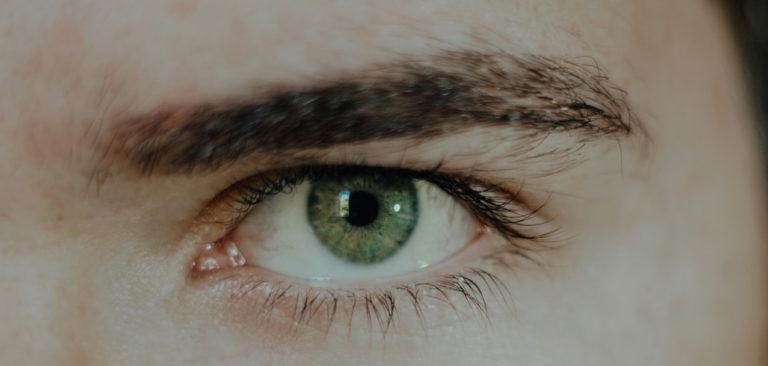Keratopigmentation, also known as corneal tattooing or corneal pigmentation, is a specialized procedure in ophthalmology aimed at altering the color of the cornea for cosmetic or therapeutic purposes. It involves the introduction of color pigments into the corneal stroma to change or enhance the natural color of the eye. This procedure is typically performed by experienced ophthalmologists or oculoplastic surgeons using advanced surgical techniques and equipment.
What Is Keratopigmentation Surgery?
The cornea, the transparent outermost layer of the eye, plays a crucial role in focusing light onto the retina, thus enabling clear vision. Keratopigmentation modifies the appearance of the cornea by introducing pigments to change its color. This can be done for various reasons, including cosmetic enhancement, restoration of the iris color, or therapeutic purposes such as masking corneal opacities.
Dr Ferrari’s Annular Keratopigmentation Method
- Anesthesia and Duration: Patients undergo a painless procedure lasting approximately one hour, facilitated by local anesthesia to ensure comfort throughout. This approach prioritizes patient well-being and minimizes discomfort during the operation.
- Surgical Technique: Spearheaded by Dr. Ferrari, the annular keratopigmentation procedure employs a meticulously controlled approach. It initiates with the creation of a precise circular micro-tunnel within the cornea, meticulously crafted using advanced femtosecond laser technology. This method underscores precision and accuracy in every step, laying the foundation for successful outcomes.
- Pigment Application: After the micro intracorneal tunnel’s formation, the application of pigment becomes a meticulous process. Carefully selected pigments are delicately applied to conceal the eye’s natural color, achieving the desired color transformation with finesse and precision. This meticulous approach ensures uniformity and natural-looking results.
- Preservation of Eye Structure: This surgical intervention preserves the integrity of the eye’s internal structures. Avoiding the use of eye implants, this method prioritizes safety and efficacy, offering patients peace of mind and minimizing potential risks associated with invasive procedures.
- Safety Measures: The surgeons emphasize on safety through three key rules of caution:
- Utilization of a specialized femtosecond laser, intricately calibrated and programmed for the procedure’s intricacies.
- Surgeons execute precise surgical maneuvers with the aid of this indispensable tool, ensuring unparalleled accuracy and efficacy.
- Only Neoris dyes, including blue, green, brown, and white, are employed to guarantee optimal and dependable outcomes. Neoris dyes are the only dyes in the market developed specifically for keratopigmentation.
Learn More About Dr Ferrari’s Innovative Technique
Improved Appearance and Vision: The Benefits of Keratopigmentation
Color change procedures for your eye present a wide range of benefits. Whilst most people get the procedure done for cosmetic purposes, eye tattooing has been a procedure performed for centuries for medical reasons to treat corneal and iris abnormalities. Here are some of the key benefits:
Cosmetic Enhancement
Keratopigmentation empowers individuals to transform their eye color for aesthetic purposes, whether seeking a subtle shift or a bold transformation. With skilled surgical techniques, patients can attain their desired look, enhancing their appearance and confidence. This procedure caters to diverse preferences, enabling patients to explore a spectrum of eye colors, from soft browns to vibrant blues or even unconventional shades like amethyst or emerald.
Restoration of Iris Color
Keratopigmentation serves as a beacon of hope for individuals grappling with iris depigmentation stemming from various causes such as trauma, illness, or surgical procedures. By meticulously implanting pigments into the cornea, ophthalmologists can recreate the natural hue of the iris, reinstating not only the physical aspect but also bolstering emotional well-being and self-assurance. This restoration journey imbues individuals with a renewed sense of identity and wholeness.
Therapeutic Purposes
Beyond its cosmetic allure, keratopigmentation holds immense therapeutic value, particularly for individuals plagued by corneal opacities that impede visual clarity and induce discomfort. By concealing these opacities with carefully selected pigments, this procedure can significantly enhance visual acuity and quality of life. Patients emerge from the shadows of visual impairment, embracing newfound clarity and freedom to navigate the world with confidence.
Permanent Results
Unlike temporary solutions such as colored contact lenses, which necessitate frequent replacements and maintenance, keratopigmentation offers enduring outcomes. Once the pigments integrate into the cornea, they undergo minimal changes over time, ensuring a lasting transformation. This permanence not only streamlines the postoperative journey for patients but also fosters a sense of assurance and stability, sparing them the inconvenience of recurrent procedures.
Customization
Keratopigmentation epitomizes the fusion of artistry and medical science, allowing for meticulous customization of corneal color tailored to each patient’s preferences and personality. Whether envisioning a naturalistic brown akin to rich mahogany or a captivating seafoam green reminiscent of tropical waters, individuals can get their dream eye color. This bespoke approach transcends conventional boundaries, enabling patients to express their unique identity through their gaze.
Before and After Pictures of Keratopigmentation
Are There Any Risks Associated With Keratopigmentation?
The cosmetic procedure for permanent eye color alteration has garnered negative attention within ophthalmological discourse, primarily due to the prevalent methods of permanent color modification: colored implants and laser depigmentation of the iris. Colored implants, akin to permanent contact lenses, pose inherent risks, including vision impairment, while laser-induced depigmentation may precipitate complications like glaucoma.
To mitigate these potential risks, Dr. Ferrari has innovated a novel and secure eye color alteration procedure that addresses the aforementioned concerns. To safeguard against vision impairment or intraocular complications, Dr. Ferrari employs a precise femtosecond laser to create a circular micro-tunnel in the cornea.
Through this meticulous approach, he applies a specialized pigment to conceal the natural color, offering a controlled and safe color transformation. This pioneering technique presents a viable and secure alternative, ensuring patient safety and optimal outcomes.
Is Keratopigmentation Painful?
Keratopigmentation, utilizing techniques like femtosecond laser-assisted procedures, typically involves minimal discomfort. The process entails creating precise corneal tunnels with advanced technology, followed by the application of pigments to achieve the desired color change. While adverse events are possible, including rare complications, the procedure is generally well-tolerated.
Compared to other eye color-changing procedures, keratopigmentation offers a relatively pain-free experience, making it a favorable option for individuals seeking safe and effective medical procedures for altering eye color.
Try The Neoris Simulator
What Does Keratopigmentation Recovery Entail?
Keratopigmentation recovery involves a healing process where the cornea, being the cornerstone of vision, undergoes restoration post-procedure. Patients are typically advised on postoperative care to ensure a healthy cornea and minimize the risk of infection. This period allows for the integration of pigments and the stabilization of color change techniques. Diligent adherence to recovery guidelines over the weeks following your procedure promotes optimal healing and reduces the likelihood of complications, ensuring a successful outcome.
10 Tips to Make Keratopigmentation Recovery Easier
- Follow Postoperative Instructions: Adhere to the guidance provided by your surgeon meticulously to promote optimal healing and minimize complications.
- Attend Follow-Up Appointments: Attend all the scheduled follow-up appointments to allow your surgeon to monitor your progress and address any concerns promptly.
- Use Prescribed Medications: Take any prescribed medications as directed to manage discomfort, prevent infection, and promote healing.
- Protect Your Eyes: Shield your eyes from irritants, dust, and bright light by wearing sunglasses outdoors and avoiding activities that may pose a risk of injury.
- Avoid Rubbing Your Eyes: Refrain from rubbing or touching your eyes to prevent dislodging the pigments and interfering with the healing process.
- Maintain Good Hygiene: Keep your eyes clean and free from debris by gently cleansing them as recommended by your surgeon.
- Stay Hydrated and Eat Nutritious Foods: Stay hydrated and consume a balanced diet rich in vitamins and minerals to support overall health and facilitate healing.
- Rest and Relaxation: Allow your eyes adequate rest and avoid strenuous activities that may strain them during the initial recovery period.
- Communicate with Your Surgeon: Keep an open line of communication with your surgeon and promptly report any unusual symptoms or concerns that arise during the recovery process.
- Be Patient: Understand that the healing process takes time, and the full results of keratopigmentation may not be evident immediately. Patience and persistence are key to achieving the desired outcome.
Keratopigmentation Pre and Post Operation Information
How to properly prepare for the surgery
- Take a shower and wash your hair on the day of the surgery so that the surgical environment is as clean as possible.
- Wear clean and comfortable clothes.
- Come without makeup or face powder
- Remove your fake eyelashes if you wear them.
- Have a light lunch before the surgery.
- Do not wear contact lenses on the day of the surgery
After the surgery
- Your vision will be a little blurred for a few hours.
- It is advisable to return to the hotel and start putting the drops (which will be prescribed on the morning of the operation) 2 hours after the surgery.
- Wear sunglasses out.
- It is best to come accompanied, but if you are alone, you will see enough to take a taxi or go on foot at the hotel.
- It is authorized to smoke after the operation.
- It is authorized to consume alcohol after the operation (unless you take the “Izalgi” painkiller prescribed on the morning of the operation).
- Wait 2 days to take a shower and wash your hair. Taking a bath is allowed.
- Wait 2 weeks to wear corrective lenses.
- Wait 2 weeks to go to the pool.
- Wait 3 days to start doing sports again.
- You will be able to travel and fly the day after the procedure.
- It is strongly recommended not to drive during the hours following the procedure.
Keratopigmentation Services
The surgeons on the Neoris platform are distinguished ophthalmic surgeons, renowned worldwide for their unrivalled expertise. Together with their dedicated team based in clinics around the world, they have successfully performed thousands of keratopigmentation operations, an astounding achievement accounting for almost 90% of such procedures performed worldwide.





